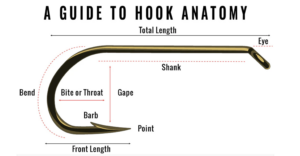Zebra Midge- A versatile pattern that imitates Chironomids…the tiny flies that are everywhere…trout love em and get fat on em. This is a simple pattern with lots of options. Easy tie…perfect for your first pattern to learn to tie flies
1. Set up your vise. Please sure you have pinched the barb ( or use barbless hooks) …this is for your safety as well as the fish. Select an appropriate size bead and install the bead on the hook. Mount the hook on the vise.
Is the hook secure? Is the vise secure? Can you easily remove and mount the hook? Is there enough room beneath the hook to hang your bobbin? Can you easily reach and see the hook?
2. Thread your bobbin and adjust the tension as necessary. Do you know how to adjust bobbin tension for your bobbin? Tension can be increased dynamically – on the go – by squeezing!
3. Familiarize yourself with the parts to the hook. The eye, point, barb area are used as landmarks along the shaft of the hook. The gap and the shaft are used as rulers to size fly correctly. Think in terms of proportions…most flies have a two thirds abdomen and one third thorax proportion.
4. Mount a hook with the shaft level and the barb area exposed. Starting the thread on the hook, tight wraps, and the half hitch are fundamental skills which we will learn before attempting the zebra midge.
Tying the zebra midge. Note: midges are also called chironomids. This large – size 6, 8 or 10 – black zebra midge with a white bead head is also called the Snow Cone Chironomid; it’s the go-to fly for Lahontan Cutthroat trout at Pyramid Lake, Nevada.
1. Mount bead on hook; hook point into small bead hole! Mount hook on vise, shaft level – or if using a curved hook, the shaft nearest the eye level – and the barb exposed.
2. Tie on, half hitch near the bead.
3. This is a lengthy step in which the rib is tied on and the tapered body is wound. Tie on the rib
just behind the bead. Keeping the rib on the top of the shaft, wrap back with touching wraps to just past the start of the bend. Continuing with tight, touching wraps in a stair stepped pattern, (see diagram) wrap the tapered body. If necessary, untwist thread, smooth tapered body. Half hitch just behind bead.
4. Wrap and tie off ribbing. Wrap ribbing evenly toward eye using 4-8 turns to get there. Holding ribbing in your right hand, flop bobbin and thread over ribbing with left hand to catch. Repeat. Tie off. Fatigue ribbing to snap off (or cut it) then bury end with a few wraps of thread. If desired wrap collar behind bead. Finish with two or three half hitches behind bead.
Note: There are many variations on the simple Zebra Midge. Take a look at the bottom video demonstrating the Serendipity…a fly invented to imitate the countless midge population on the Madison river. Just like the Zebra Midge, this fly is simple with only a couple materials used. The Serendipity is a guide pattern …a pattern that can be tied in the dozens very quickly. Tip….try a body with krystal flash and rib the body with wire. A tiny bit of flash attracts attention, particularly in tiny flies. Also, vary the colors depending on what you learn on your specific water of choice.
- Hook: Curved nymph hook # 10-20
- Tying thread: 140 denier Black or other colors ( Olive and Red are good alternatives)
- Rib: Silver wire
- Abdomen: Thread
- Bead, Silver or White

